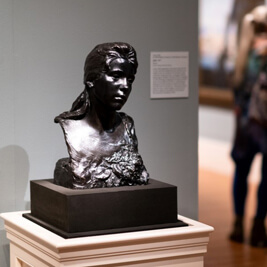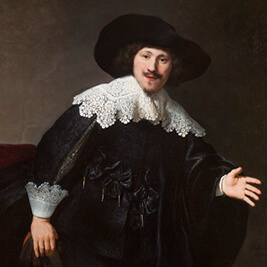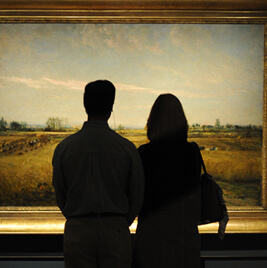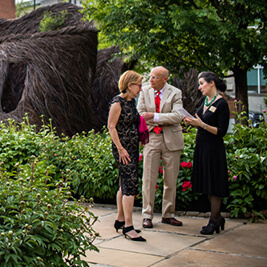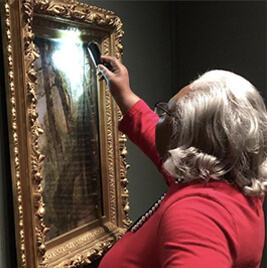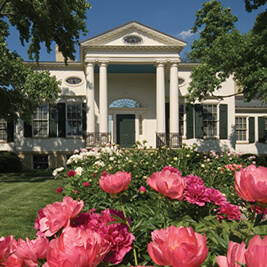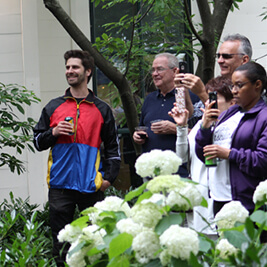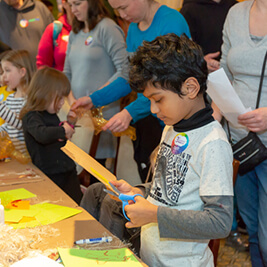- Do + See
- Dine + Host
- Give + Join
- Educate + Learn
A Naturalist’s Guide to Two Works in the Taft Collection
by Tamera Lenz Muente, Associate Curator
Just as it has been difficult for art lovers to be separated from museums at this time, it has been challenging for me personally and professionally to not have access to real works of art as I continue my duties as associate curator from home. I have been grateful that I still have access to the outdoors to practice one of my hobbies: being an amateur naturalist. Natural history is the study of living things in nature through careful observation. Every new thing I encounter feels like a discovery, and I am filled with wonder as if I were still a child. In particular, I love watching birds, identifying species new to me and learning bird calls I’ve never heard before. I am also enjoying spotting native wildflowers as they emerge this spring. As I’ve been away from the museum, I’ve been thinking about the Taft garden coming to life, with redbuds and daffodils blooming now, and also about works in the Taft collection with extraordinary connections to nature.
Nature on a Chinese Vase
One of my favorites with beautiful details from the natural world is the Taft’s 18th-century Chinese Vase with Kingfisher and Lotus. The vase features a small bird called a kingfisher perched on a lotus stem, surrounded by other birds, aquatic plants, and insects. Kingfishers are exciting to see in nature as they hunt along ponds and streams. The one on the vase doesn’t look exactly like the species you can see in the Cincinnati area: the belted kingfisher. The only kingfisher widespread in the United States, the belted kingfisher is gray-blue and white and sports a spiky crest on its oversized head (the female also has a rusty band on her chest).
With its rounded head, long pointed beak, and reddish breast, the bird on the vase more closely resembles the common kingfisher native to China and other parts of Asia. However, the artist took some liberties: in reality, the common kingfisher's head, back, and wings are electric blue—so stunning that its feathers were used to embellish elaborate jewelry and headdresses for the imperial court. The artist was using a limited enamel palette called famille verte (green family), which may be why he depicted the kingfisher with greenish feather instead.
You can see many species similar to the birds and plants that decorate this vase in the Cincinnati region. American lotuses bloom in area ponds in summer. Arrowhead—the arrow-shaped leaves that appear at the bottom of the vase—can be seen in shallow water as well. If visiting a pond before dusk, you might see swallows swooping above the water to catch insects. Pairs of swallows decorate the shoulders of the vase, and another bird that resembles a swallow appears on the vase’s neck. As the vase is turned, butterflies and dragonflies become visible. Many varieties of these insects frequent our area ponds in the summertime. Although the artist simplified and stylized some of its details, the vase comprises many flora and fauna of a shallow water ecosystem.
Nature in a Dutch Still Life
From China to the Netherlands, nature has inspired artists across centuries and geographical locations. Another of my favorites in the Taft Collection features cacophony of eye-popping natural details. The painted specimen in Van Der Ast's still life include thirty-two species of flowers, eleven kinds of shells, eight types of fruit, five insects and spiders, two lizards and a parrot—each one identifiable today!
Different from the Chinese vase, which portrays birds, insects, and plants from a certain environment, this still life combines flowers that bloom in different seasons and far-flung locales, and animals from around the globe. For example, the parrot—a turquoise-fronted Amazon—hails from South America, where it is still found in the wild even though it has become one of the world’s most popular parrots to keep as a pet. There is so much to explore in this painting! I imagine its owner would have never gotten tired of it.
Moving from left to right, starting with the red admiral butterfly on the left, the eyes move over tiny, pale bird cherry blossoms, a delicate pink carnation, and a fiery tulip hybrid, until a surprise appears. There, in the center of the arrangement, a large fly lurks on the feathery petal of a blue iris. Continuing to the right, a pink tulip leads to a stalk of larkspur, which points to a spider hanging from a web, emerging from the shadows.
Both the Vase with Kingfisher and Lotus and Van der Ast’s remarkable still life remind me that looking closely is very rewarding, and is the guiding principle for anyone who takes pleasure in observing nature or looking at art.

